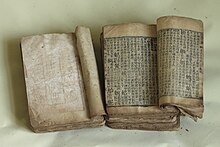Kangxi Dictionary
| Kangxi Dictionary | |||||||
|---|---|---|---|---|---|---|---|
Hán-Nôm 康熙字典 | | ||||||
| Korean name | |||||||
| Hangul | 강희자전 | ||||||
| Hanja | 康熙字典 | ||||||
| |||||||
| Japanese name | |||||||
| Kanji | 康熙字典 | ||||||
| Hiragana | こうきじてん | ||||||
| |||||||
The Kangxi Dictionary (
The text is available in many forms, from Qing dynasty
Compilation
In his preface to the 1716 printing, the emperor wrote:
- Every time I read widely in the commentaries on the classics, the pronunciations and meanings are complex and obscure, and each person protects his own explanations according to his individual view, so that it is not likely that any will communicate everything without gaps. Thus I have ordered the scholar officials to acquire all the old documents, then to arrange them and revise them.[3]
The emperor chose the term zidian himself—at the time not having a meaning of 'dictionary', but rather something like a 'compendium' of 'standard' or 'model' characters, as to show their correct forms and authoritative pronunciations. The compendium was generally referred to simply as zidian, which later became a standard Chinese word for 'dictionary' in the 19th century, and used to title practically every Chinese dictionary published since then.
The original editors included Zhang Yushu (1642–1711), Chen Tingjing (1639–1712), and a further staff of thirty men. However, both Zhang and Chen died within a year of their appointment to the task, and the work was taken up by scholars of the Hanlin Academy. The compilation was based partly on two Ming dynasty dictionaries: the 1615 Zihui by Mei Yingzuo, and the 1627 Zhengzitong by Zhang Zilie.[5]
The imperial edict required that the project be completed within a five-year span. As such, errors were inevitable. Although the emperor's preface said "each and every definition is given in detail and every single pronunciation is provided".

The supplemented dictionary contains 47,035 distinct character entries, in addition to 1,995
The character entries provide definitions and pronunciations in both traditional
The missionary Walter Henry Medhurst, an early translator of the Bible into Chinese, compiled Medhurst's Chinese and English Dictionary (1842–1843) in two volumes, with Chinese sourced from the Kangxi Dictionary.[11]
The dictionary is one of several used by the Ideographic Research Group for the Unicode standard.
Structure
- Preface by the Kangxi Emperor: pp. 1–6 (御製序)
- Notes: pp. 7–12 (凡例)
- Phonology: pp. 13–40 (等韻)
- Table of contents: pp. 41–49 (總目)
- Index of characters: pp. 50–71 (檢字)
- The dictionary proper: pp. 75–1631
- Main text: pp. 75–1538
- Addendum contents: pp. 1539–1544 (補遺)
- Addendum text: pp. 1545–1576
- Appendix contents (No–source–characters): pp. 1577–1583 (備考)
- Appendix text: pp. 1585–1631
- Postscript: pp. 1633–1635 (後記)
- Textual research: pp. 1637–1683 (考證)
See also
- Dai Kan-Wa jiten(Great Chinese–Japanese Dictionary)
- Han-Han Dae Sajeon(Korean hanja-to-hangul dictionaries)
- Hanyu Da Zidian (Great Compendium of Chinese Characters)
- List of Kangxi radicals
- Peiwen Yunfu (Rhyme Storehouse of Esteemed Phrases)
- Zhonghua Da Zidian (Chinese Great Dictionary)
References
- Billings, Timothy (April 2007), Making Friends with the Kangxi zidian 康熙字典, archived from the original on 2012-02-07, Occasional paper with translation of Kangxi Emperor's preface 御製康熙字典序
- Creamer, Thomas B. I. (1992), "Lexicography and the history of the Chinese language", in History, Languages, and Lexicographers, (Lexicographica, Series maior 41), ed. by Ladislav Zgusta, Niemeyer, 105–135.
- Mair, Victor H. (1998), "Tzu-shu 字書 or tzu-tien 字典 (dictionaries)," in The Indiana Companion to Traditional Chinese Literature (Volume 2), ed. by William H. Nienhauser Jr., et al., SMC Publishing, 165–172.
- Medhurst, Walter Henry (1842), [Chinese and English dictionary, containing all the words in the Chinese imperial dictionary; arranged according to the radicals], 2 vols., Parapattan. Google Books: Volume I, Volume II.
- Teng, Ssu-yü and Biggerstaff, Knight. 1971. An Annotated Bibliography of Selected Chinese Reference Works, 3rd ed. Cambridge, Massachusetts: Harvard University Press. ISBN 0-674-03851-7
- Vedal, Nathan (2013), ""Preferring Omission over Falsity": The politics of compilation in the Kangxi Classic of Characters", Historiographia Linguistica, 40: 3–37,
- ISBN 9780998888309.
Notes
- ^ "重啟康熙字典字頭校對工作 - 康熙字典論壇 - 康熙字典与倉頡之友 - Powered by Discuz!". www.chinesecj.com. Retrieved 2023-03-28.
- ^ a b Wilkinson (2018), p. 84.
- ^ Billings (2007).
- ^ Wilkinson (2018), p. 34.
- ^ Wilkinson (2018), p. 85.
- ^ Tr. Creamer 1992: 117.
- ^ Mair 1998: 169.
- ^ Creamer 1992: 117.
- ^ 李雪涛《一位传教士记载的王锡侯〈字贯〉案》
- ^ Teng and Biggerstaff 1971:130
- ^ Wilkinson (2018), p. 89.
External links
- Kangxi Zidian (Tongwen Shuju edition) with Chinese Text Project dictionary lookup
- Online version
- Japanese online edition Bibliothèque numérique mondiale
- in English, with brief history of the dictionary, on Chinaknowledge.de
- The Chinese Language Dictionary Homepage, in Chinese only
- Revised EPUB Version
